The following Interregnum newsletter was printed and handed out at both churches in the Parish on 25 September:
In last week’s Interregnum news we explained about the Parish open meeting the PCC has arranged at 5:00pm on 8 October 2022 in St Mary & St Giles church when you can learn more about the respective perspectives of Forward in Faith and The Society as well as
Anglo-Catholic priests who are in favour of the ordination of women. If you need a lift to the meeting, please speak to any PCC member. You can ask questions, hear comments from others and reflect on your perspective before telling the PCC your views via a questionnaire which will be handed out at the end of the meeting for return by 16 October 2022. If you are unable to attend the meeting, you will be able to obtain the questionnaire on 9 October in both churches or by contacting Anna Page annacpage.parish@gmail.com 07944 192921.
The next Interregnum newsletter will outline the timetable and process for the Interregnum.
The PCC has been gathering information which we plan to put on display in both churches as there are several pages of information to read. We also plan to provide all the information in a document hosted on the Parish website for you to read online or download and print.
In the meantime, you may wish to read the following which forms part of the information the PCC has compiled:
Factsheet: Women priests in the Church of England (2019)
https://religionmediacentre.org.uk/factsheets/25-years-of-women-as-priests-in-the-church-of-england/ (written in 2019)
Women have now been able to become priests in the Church of England for 25 years. This marked the culmination of decades of wrangling and activism, although arguments around the representation of women in senior positions in the church have continued in the quarter-century since.
When did women become able to be ordained as priests?
The Movement for the Ordination of Women was founded in 1979 and was the main group campaigning for women to become priests. It wound up in 1994 after it had achieved its objective. A group called Watch https://womenandthechurch.org/ was formed in 1996 to campaign for gender justice in the church.
After 19 years of debate, the Church of England’s parliament – the General Synod – took the decision in 1992 to allow women’s ordination. The measure had to be approved by a two-thirds majority in each of the synod’s three houses of bishops, clergy and laity. It passed by a margin of only two votes among lay people.
Thirty-two women were priested at a service in Bristol Cathedral on 12 March, 1994. They were ordained in alphabetical order, which means that Angela Berners-Wilson is officially the Church of England’s first woman priest.
She had previously served 15 years as a deaconess and deacon and went on to be a chaplain at Bath University. She is now a parish priest and a prebendary at Wells Cathedral.
What about women bishops?
Figures for 2017 show that 28% of clergy are women and 23% of senior leadership positions are held by women https://www.churchofengland.org/sites/default/files/2018-08/Ministry Statistics 2017_final report_v2.pdf.
On 17 November 2014, the General Synod voted in favour of removing the legal obstacles preventing women from becoming bishops, ending a process that began nine years earlier.
Libby Lane became the first woman to serve as a bishop of the Church of England when she was consecrated in 2015 as suffragan Bishop of Stockport in 2015, an assistant bishop in the diocese of Chester. She is now the diocesan Bishop of Derby.
As of March 2019, there are 18 women bishops: London, Bristol, Gloucester, Newcastle, Derby, Aston, Crediton, Dorking, Hull, Jarrow, Lancaster, Loughborough, Penrith, Repton, Ripon, Sherborne, Taunton and Warrington https://en.wikipedia.org/wiki/List_of_female_Anglican_bishops.
Five are diocesan bishops with seats in the House of Lords, including the Rt Rev Sarah Mullally, Bishop of London, and the third most senior bishop in the Church of England.
What was the resistance to women priests?
In 1993 the Act of Synod was passed allowing for the creation of “flying bishops” (provincial episcopal visitors) to minister to churches that did not accept the ordination of women. Today there are seven: the bishops of Richborough (based in St Albans), Ebbsfleet, Maidstone, Fulham, Beverley, Wakefield and Burnley.
363 parishes https://www.churchofengland.org/sites/default/files/2017-11/Church Statistics 2009-2010.pdf (from a total of 13,000) opted to come under the care of these “flying bishops” (2010 stats). 1,000 parishes object to women priests working in their churches (2010 stats as above). 430 priests resigned https://www.churchtimes.co.uk/articles/2004/20-february/news/uk/conscience-payouts-to-priests-top-26m from the Church of England over the issue and claimed compensation.
Forward in Faith https://www.forwardinfaith.com/index.php was set up in 1992 after the vote to allow women’s ordination. It has branches in many parts of the UK and says it is committed to the catholic faith and order, and opposed to women priests and bishops. The Bishop of Wakefield chairs the group.
Reform https://www.reform.org.uk/is a conservative evangelical group set up in 1993 against the ordination of women, now also campaigning on issues such as homosexuality. It is led by the Rev Mark Burkill, from Leyton, east London.
There was also a Group for Rescinding the Act of Synod which called for the law which paid compensation to those who resigned and set up structures for opponents of women’s ordination to be withdrawn, calling it “institutionally sexist”.
What are the theological arguments in this debate?
Opponents of women’s ordination may draw on the following arguments:
- The Bible says women should not hold authority over men (Ephesians 5:21-22 says the husband is the head of the wife, the ‘headship’ argument)
- The 12 disciples were all men and there has been a 2,000-year line of male “apostolic succession”
- Ordaining women as priests is an obstacle to unity with the Roman Catholics and Orthodox churches, which do not allow women priests
- A priest represents Jesus at the altar and Jesus was a man
Those in favour of women’s ordination counter that:
- The text from Ephesians should be read in its cultural context. Elsewhere St Paul said “in Christ there is no male or female” (Galatians 3:28)
- Jesus had many women disciples, including Mary Magdalene
- Unity talks continue but Roman Catholics and the Orthodox do not accept Anglican ordinations or sacraments are valid. The issue of women’s ordination is one of many obstacles to unity.
- Jesus is representative of all humanity, male and female

